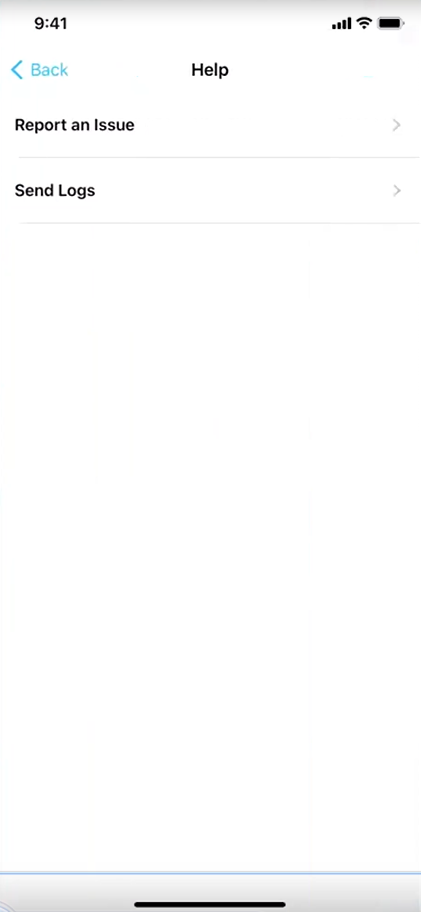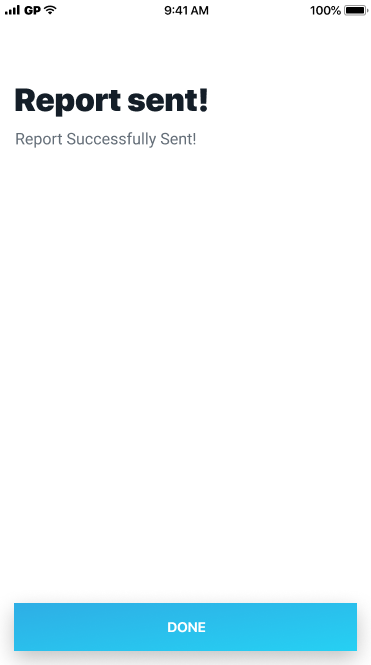Download PDF
GlobalProtect
Report an Issue From the GlobalProtect App for iOS
Table of Contents
Expand All
|
Collapse All
GlobalProtect Docs
-
-
-
-
- 6.3
- 6.2
- 6.1
- 6.0
-
- 6.3
- 6.2
- 6.1
- 6.0
Report an Issue From the GlobalProtect App for iOS
When you experience unusual behavior such as poor network performance or a connection is not
established with the portal and gateway, you can report an issue directly to Strata
Logging Service to which your administrator can access. You no longer need to
manually collect and send the GlobalProtect app logs through email or to store them
on a cloud drive.
To display
the Report an Issue option on the GlobalProtect
app, your administrator must enable the GlobalProtect app
log collection for troubleshooting on the GlobalProtect portal.
- Connect to the GlobalProtect portal or gateway.
- Launch the GlobalProtect app.Enter the GlobalProtect portal address.(Optional) Depending on the connection mode, tap Connect to initiate the connection.Allow GlobalProtect to add VPN configurations to your endpoint. This setting enables GlobalProtect to filter and monitor network activity on the endpoint when you are using the VPN.Enter your iPhone or iPad passcode to confirm that you want to add VPN configurations to your endpoint.(Optional) If prompted, enter your Username and Password and then SIGN IN.When the home screen appears, verify that your connection has established successfully. If the connection is successful, the home screen displays the CONNECTED state.(Optional) By default, the endpoint automatically connects to the Best Available gateway based on the configuration that the administrator defines and the response times of the available gateways. To connect to a different gateway, tap the gateway drop-down at the bottom of the home screen, and then select a gateway from the list (external gateways only).View information about your GlobalProtect connection.After you establish the GlobalProtect connection, launch the GlobalProtect app. Tap the settings icon to open the settings menu. From the settings menu, tap SETTINGS to view information about your connection, including the Portal address and connection Status.Report an issue from the GlobalProtect app from the end user’s endpoint.After you launch the app, tap HELP to report an issue from your endpoint.
- Tap Report an Issue.
![]() Enable the GlobalProtect app to run diagnostic tests and to include diagnostic logs. Both diagnostic and troubleshooting logs are collected and sent to Strata Logging Service as a compact troubleshooting report.After the diagnostic tests are successfully completed, the GlobalProtect debug log files are uploaded to Strata Logging Service from your endpoint.If you do not enable the app to run diagnostic tests and to include diagnostic logs, only troubleshooting logs are collected and sent to Strata Logging Service as a compact troubleshooting report. The GlobalProtect app checks for the report files (pan_gp.trb.log or pan_gp_trbl.log) that are automatically generated in .json format. A notification message appears if no issues were found in the troubleshooting logs. Click Retry to check if the pan_gp.trb*.log files exist.Select the Run Diagnostic Tests and Include Diagnostic Logs check box.Tap CONTINUE to allow the app to create a troubleshooting log and to send the report to your administrator’s Strata Logging Service instance.The results of the end-to-end diagnostic tests are stored in the pan_gp_diag.log file in .json format and sent to your administrator’s Strata Logging Service instance along with the pan_gp.trb*.log files.The results of the end-to-end diagnostic tests are stored in the pan_gp_diag.log file in .json format and sent to your administrator’s Strata Logging Service instance along with the pan_gp.trb*.log files. The GlobalProtect app can run diagnostic tests with a tunnel or without a tunnel. For example, you might want to enter your GlobalProtect login credentials prior to the app connecting and running diagnostic tests through the tunnel.
Enable the GlobalProtect app to run diagnostic tests and to include diagnostic logs. Both diagnostic and troubleshooting logs are collected and sent to Strata Logging Service as a compact troubleshooting report.After the diagnostic tests are successfully completed, the GlobalProtect debug log files are uploaded to Strata Logging Service from your endpoint.If you do not enable the app to run diagnostic tests and to include diagnostic logs, only troubleshooting logs are collected and sent to Strata Logging Service as a compact troubleshooting report. The GlobalProtect app checks for the report files (pan_gp.trb.log or pan_gp_trbl.log) that are automatically generated in .json format. A notification message appears if no issues were found in the troubleshooting logs. Click Retry to check if the pan_gp.trb*.log files exist.Select the Run Diagnostic Tests and Include Diagnostic Logs check box.Tap CONTINUE to allow the app to create a troubleshooting log and to send the report to your administrator’s Strata Logging Service instance.The results of the end-to-end diagnostic tests are stored in the pan_gp_diag.log file in .json format and sent to your administrator’s Strata Logging Service instance along with the pan_gp.trb*.log files.The results of the end-to-end diagnostic tests are stored in the pan_gp_diag.log file in .json format and sent to your administrator’s Strata Logging Service instance along with the pan_gp.trb*.log files. The GlobalProtect app can run diagnostic tests with a tunnel or without a tunnel. For example, you might want to enter your GlobalProtect login credentials prior to the app connecting and running diagnostic tests through the tunnel.![]() A message pops-up, confirming that the app is running diagnostic tests only if you selected the Run Diagnostic Tests and Include Diagnostic Logs check box.
A message pops-up, confirming that the app is running diagnostic tests only if you selected the Run Diagnostic Tests and Include Diagnostic Logs check box.![]() A message pops-up, confirming that the app is sending the report to Strata Logging Service.
A message pops-up, confirming that the app is sending the report to Strata Logging Service.![]() Tap DONE to confirm that the app successfully sent the report to Strata Logging Service.
Tap DONE to confirm that the app successfully sent the report to Strata Logging Service.![]()





